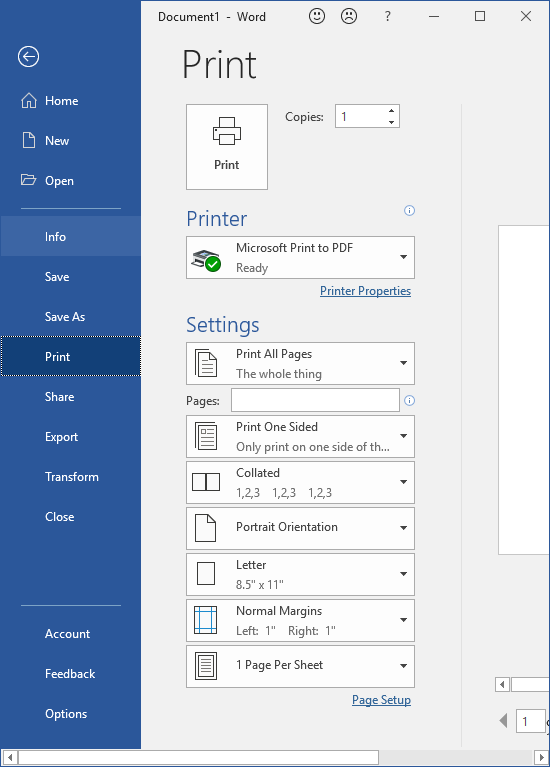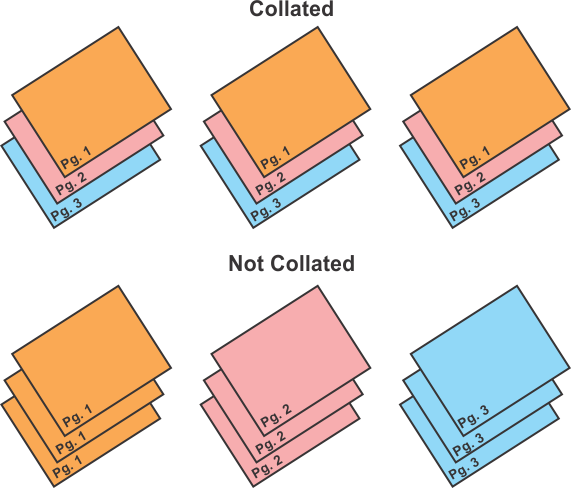

- #PRINT COLLATE DRIVER#
- #PRINT COLLATE FULL#

Uncollate: Collated pages are in proper numerical order in each set. Signature Booklet: The collated pages of one folded and trimmed form, making up one section of a bound book.

Registration: Putting two or more images together so that they are exactly aligned and producing a sharp image.For example, if you print a five-page document ten times, you might get ten page ones, ten page twos, and so on in piles.
#PRINT COLLATE FULL#
Original: Your typeset hard copy or digital file from which copies are produced. A: 'Collate' is not the same as 'print in reverse order.' To collate means that if you print multiple copies of multiple-page documents, the copies will be grouped such that each full document has all the pages in order.Margins: The border around the page where the printers can't print.false will print each page by the number of copies specified before printing the. Setting Collate to true will print a complete copy of the document before the first page of the next copy is printed. Set the Copies property to specify the number of copies to print. Click on the Print button to print the document. (You can select either Collated or Uncollated.) 5. Examine the controls in the Settings area. Head-To-Toe: Printing the top of the front of the page back to back with the bottom of the page on the back side. Collating is performed only when the number of copies is greater than 1. Using the Copies control, specify the number of copies you wish to print.Head-To-Head: Printing the top of the front of the page back to back with the top of the page on the back side. In printing, collating refers to sequentially layering the pages of a multiple page document, book, brochure, etc.Duplex or Back to Back: Printing an image on both sides of a sheet of paper.We ask for photos and graphics at 300 dpi. Because each document again has multiple pages that should be sequentially arranged to form a set or package. What Does Collate Mean When Printing When printing multiple sets of a document, manually sequencing the page is a great deal of labor. Laser printers typically reach 300 DPI, though 600 DPI is becoming more common. And collate printing means having your printed document arranged in a predetermined sequential order. A measure of resolution for printers, scanners and displays.
#PRINT COLLATE DRIVER#
Printer Default prints using the default print driver collation.
Color Separation: Separating color artwork into separate colors, such as cyan, magenta, yellow, and black for presses. Use Application Collate prints using the collation settings in the application Print window. Bleed: Extending an image beyond the trim marks to eliminate borders or margins in the finished piece. *In order to include duplicate records you have to use UNION ALL instead of UNION. Collate refers to the gathering and subsequent arrangement of sheets of. All pages of one copy of the document print before the. If multiple copies are being printed, and 'collate' is selected, pages 1,2,3,4 and 5 would print in that order, then repeat. For example, imagine printing a document that is five pages long. Check out the printer preview page the next time you print a paper. When referring to printing, collate is a term used to describe how printed material is organized. That is, rather than printing separate papers, the printer ‘’collects’’ them all together to make a full set. *Depending on how many duplicate rows you want to print, the UNION ALL operator may have to be used more than once and placed between the same SELECT statement. Collate is a term used in the printing industry to describe ‘’collate copies’’. The data returned is stored and shown in a single table. You can use the SQL UNION ALL operator to combine the result sets of 2 or more SELECT statement (FIGURE 1-3). In BarTender this can be done with a Custom SQL statement (FIGURE 1-2) and it doesn't require to make any change at your database file or table stored on the database system. However, even though such option is not natively supported in BarTender, below is discussed a possible method to overcome such limitation.įor example, supposing the table 'A' shown in the the FIGURE 1-1 is the current table linked to a BarTender document and, the table 'B' is a copy of the table 'A', if you combine one to each other, you'll be able to print all records of each copy before printing the second copy. Let's assume that your BarTender document is currently linked to a SQL Server Database that consists of a table with 3 rows and that you want to print multiple copies for each record in what order my labels will be printed by BarTender? Applicable toīased on the number of copies requested, BarTender will print all the copies of record 1, then all the copies of record 2 and so on for each selected record. So, if you've specified to print two copies per record, in this case, the printout outcome will be in this order: 1, 1, 2, 2, 3, 3īarTender does not support collate printing, that means there isn't any option to select that makes BarTender running the print job in its entirety once and then repeat, so to get the following sets of copies: 1, 2, 3, 1, 2, 3







 0 kommentar(er)
0 kommentar(er)
